A new gravel road is cut into the side of a mountain just north of Anchorage, Alaska. As the snow melts in June, the fine gravel and sand of the disturbed region quickly tumbles into the bottom of nearby streams
The addition of this fine gravel and sand changes the stream by A) decreasing the number of plants and animals that live there.
B) decreasing the number of plants but increasing the number of animals that live there.
C) increasing the number of plants but decreasing the number of animals that live there.
D) increasing the number of plants and animals that live there.
A
You might also like to view...
Briefly explain two reasons why coastal zones have a higher net primary productivity than abyssal zones.
What will be an ideal response?
Geography provides a place- or space-related ______________________ of human experience.
Fill in the blank(s) with the appropriate word(s).
The type of fault shown in this figure is a(n)
A. strike-slip fault. B. normal fault. C. reverse fault.
A typical rate of groundwater flow for many aquifers is approximately ________
A) 1 cm/day B) 4 cm/day C) 0.5 m/day D) 2 m/day